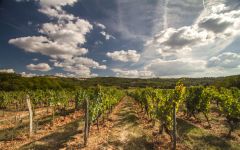Chateau Haut-Monplaisir Cahors Tradition 2016



Product Details
Your Rating
Somm Note
Winemaker Notes
Tradition is the first or introductory wine from Haut Monplaisir. As with all the domain’s cuvées, this is 100% Malbec. Tradition is made and raised primarily in concrete vats, with 30% raised in neutral barrels. Aromatically intense, with rich spicy mineral fruit, this is a long, earthy rendition of Malbec.
Other Vintages
2021-
James
Suckling -
Wine
Enthusiast
-
James
Suckling
-
Wine
Enthusiast
-
Wine
Enthusiast





Cathy and Daniel Fournié of Haut-Monplaisir farm 44.5 acres on what the locals call the third terrace of the valley floor. These terraces, or benches, are layered gravel deposits left by the river over the ages. There are three such terraces in the valley; the third is the highest, furthest from the Lot, and the best by virtue of its well-drained soils. Above the third terrace come the mountain vineyards, high on the oak-scrub hills.
Cathy took over the vineyards in 1998 from her father, who had sold the crop to négociants. She and Daniel had a keen interest in making their own wine but realized they needed help. They reached out to Pascal Verhaeghe, the dynamic proprietor of Chateau du Cèdre whose vineyards grow on the second terrace. Pascal immediately saw the potential of Haut Monplaisir's site. He could also see that if great wine were made here then Cahor's revival would be all the more successful, and that was far more important to him than possible competition between the two domaines. Thus was born the partnership between Pascal and Daniel, who together are responsible for the wines of Haut Monplaisir.

Celebrated for its bold flavors and supple texture, Malbec has enjoyed runaway success in Argentina since the late 20th century. The grape originated in Bordeaux, France, where it historically contributed color and tannin to blends. A French agronomist, who saw great potential for the variety in Mendoza’s hot, high-altitude landscape, brought Malbec to Argentina in 1868. Somm Secret—If you’re trying to please a crowd, Malbec is generally a safe bet with its combination of dense fruit and soft tannins.

Within the Southwest of France, this is the one region outside of Argentina that is today almost exclusively dependent on Malbec. Locally the variety is called Cot, and makes a dense, earthy and black fruit dominant red wine. Both the Atlantic Ocean and Mediterranean both have a strong influence on the climate of this region.
